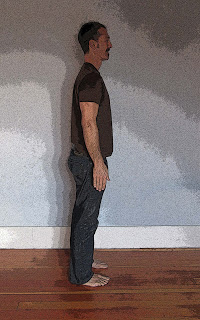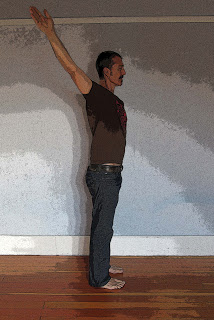by Baxter and Nina
In the coming weeks, we’re going to be introducing a set of poses you can do outside the yoga room (such as at work or the airport) or from a chair (if standing is not possible, for whatever reason). We’re starting off this new set of poses with dynamic arm circles.
This pose is great for preparing your shoulders for yoga practice, or for any task where you will be using your arms overhead (such as painting a house) or a sport that involves your arms, such as tennis. It’s also perfect for releasing tension after you’ve worked your arms or sat for hours at a desk or on a plane. And moving your arms within the complete range of motion is the best way to keep your shoulder joints healthy.
You can do arm circles standing in Mountain Pose (which is how we will show it) or sitting in a chair. Because you can do them without props and in your street clothes, it’s possible to do arm circles almost anywhere (especially if you don’t mind people giving you odd looks at the airport).
The pose has two variations: 1) front stroke: moving the arms forward, up over head, and back around to the front and 2) back stroke: moving your arms back, up over your head, and down toward the front.
Baxter prescribes arm circles for:
- Gaining flexibility in tight shoulders
- Regaining range of motion after an injury
- Arthritis, lupus, or other diseases that limit range of motion
Instructions. Start in Mountain pose, with your chest facing forward. Then make circles your arms using either in forward stroke or back stroke motions, moving with your breath (for example, moving forward and up on and inhalation, then back and down with an exhalation). Baxter generally recommends about six repetitions.



Don’t try to make perfect circles. If your shoulders are tight, you may have to allow your arms to go slightly out the side. Listen for pops, clicks and discomfort, and try to find a comfortable range of movement.
You can move both arms at the same time, alternate between right and left, or move one arm forward and up while the other is moving back and down, as if you were swimming. Relax and have fun!
Cautions. If this causes an acute or old injury to flare up, stop the movement. If you’ve dislocated your shoulder, proceed with caution, especially with the back-stroke version. If these movements cause pain, have your yoga teacher or a doctor take a look at your shoulders.
Follow Yoga for Healthy Aging on Facebook ° To order Yoga for Healthy Aging: A Guide to Lifelong Well-Being, go to Amazon, Shambhala, Indie Bound or your local bookstore.


Leave A Comment